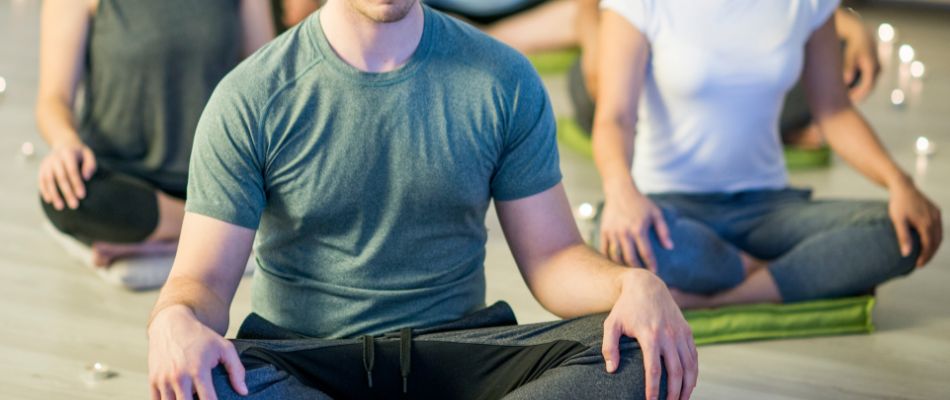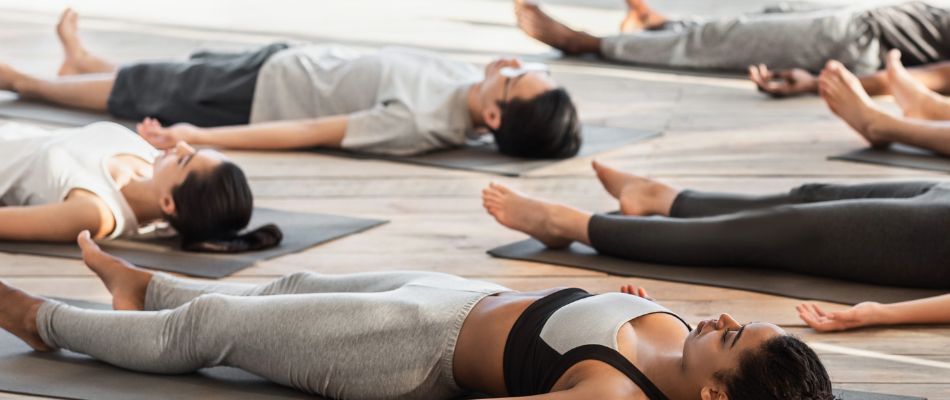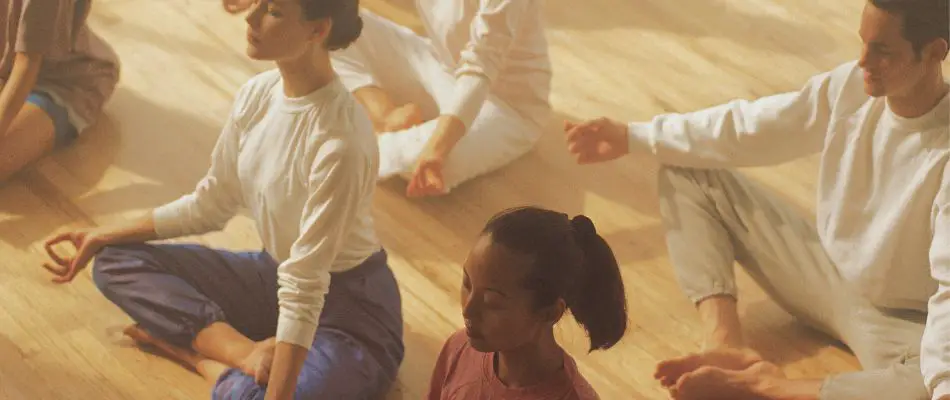One huge benefit of being both a meditation, qigong, and tai chi practitioner and teacher, is that I get to frequently interact with other practitioners who are further down the path than I am. It’s always an opportunity to pick their brains, see what they are working on, and what has had the greatest impact on the progress they are making. Regardless of personality type or having completely different interests, so many have shared that Vipassana meditation has played a big role in their progress.
This was problematic for me though. Each time I set out to try to understand what it was or even look for a Vipassana meditation retreat, I was confronted with really complex vocabulary, competing definitions about what Vipassana meditation is, and not a clear sense of whether I could do Vipassana meditation at home or absolutely had to find a Vipassana meditation centre.
The truth is that Vipassana meditation is complex but an explanation of it doesn’t have to be. And it is definitely not hard to get started (see below). It’s really interesting how Vipassana came about and even more interesting in how it influenced the modern mindfulness movement. And lastly, the strong and polarizing opinions about how mandatory a Vipassana retreat is versus doing it at home are unnecessary. The truth is that most practitioners tried it out at first and experienced profound results which led to the motivation needed to attend a 10 day Vipassana meditation retreat.
Let’s break down what Vipassana meditation is, including a couple great video explanations. Then on to it’s history because it’s newer than you would expect and if you are doing anything related to mindfulness, know that it’s an extension of Vipassana. And lastly, we will cover the spectrum from doing a 15 minute Vipassana meditation at home all the way up to an 11-hour a day, 10-day retreat.

Vipassana Meditation, often simply referred to as Vipassana, is a profound and ancient meditation technique that traces its roots back to the teachings of the Buddha Siddhartha Gautama. The term “Vipassana” itself means “insight” or “clear-seeing” in Pali, the language in which many Buddhist scriptures were originally written.
At its core, Vipassana Meditation is a systematic and disciplined practice designed to develop deep self-awareness and insight into the nature of reality, one’s own mind, and the interconnectedness of all things. Unlike some forms of meditation that focus on relaxation or concentration, Vipassana places a strong emphasis on mindfulness and observation of the present moment without attachment or aversion to any experiences that arise.
Practitioners of Vipassana meditation typically begin by observing their breath and bodily sensations. As they progress, they delve into the exploration of thoughts, emotions, and the impermanent nature of all phenomena. Through this introspective journey, individuals aim to cultivate wisdom, compassion, and liberation from suffering, aligning with the core teachings of Buddhism.
This is pretty heady stuff so check out this 3-minute video that cuts through to a much easier explanation:
Vipassana Meditation Origin Stories
There are two “historical” origins of Vipassana meditation that we need to think about in order to be able to understand it. Yes, it’s super old dating back to the original of the Buddha. But, a rebirth of insight meditation took place in Burma over the last 150 years, leading to the proliferation of mindfulness meditations that we have today.
Initial History of Vipassana Meditation
The Buddha, after years of searching for a solution to human suffering, formulated the principles of Vipassana as a way to investigate the true nature of existence and to transcend the cycle of suffering and rebirth.
Over time, the practice of Vipassana spread throughout India and beyond, becoming an integral part of various Buddhist traditions. It was preserved and transmitted through oral tradition and written scriptures, eventually reaching other parts of Asia and, in more recent times, the Western world. However, there was a falling out for 1000 years or so with Buddhism’s love for insight meditation. Beliefs in many branches of Buddhism shifted away from thinking that any person could obtain enlightenment like the Buddha so practices that cultivated this thinking we abandoned.
Meditating Vipassana in Modern Culture
In the 19th century, Burma (now Myanmar) was a hotbed of Vipassana revival lead by meditation masters like Ledi Sayadaw and Mahasi Sayadaw leading the way. They rekindled interest in Vipassana and did something no other monastic practitioners had before, they taught EVERYONE.
Unlike traditional monastic practices, these Burmese meditation masters welcomed lay practitioners, democratizing access to mindfulness meditation. This shift made meditation and mindfulness more accessible to people from all walks of life, transcending cultural and religious boundaries. By removing religious connotations but sticking to the core principles of observing bodily sensations, thoughts, and emotions without attachment or aversion, they created the bedrock of contemporary mindfulness practices.
In the late 20th and early 21st centuries, mindfulness-based interventions gained popularity in clinical settings, with mindfulness-based stress reduction (MBSR) and mindfulness-based cognitive therapy (MBCT) becoming widely accepted approaches to address issues like stress, anxiety, and depression. I believe these programs owe their existence to the Vipassana movement, which inspired contemporary mindfulness pioneers like Jon Kabat-Zinn who we wrote another essay about with some great videos.
Why Would Someone Choose Vipassana Meditation Over Other Ways to Meditate?
Vipassana Meditation profoundly impacts personal growth, mental clarity, and spiritual development. Its primary purpose is to help individuals gain deep insight into the nature of reality and the workings of their own minds. To make the point, I want to share this TEDx video of a Vipassana practitioner and documentarian. They chronicled how effective Vipassana meditation is even with prisoners.
So hopefully you are not incarcerated but also hopefully you can see that we all react to the world around us. I love the notion that we are actually reacting to our body’s reaction to the situation or stimulus. That makes progress and improvement seem so doable. Here are some key aspects of its importance and purpose that is different from other styles of meditation.
Why People Do Vipassana Meditation
- Self-Discovery: Vipassana enables individuals to explore the inner landscape of their thoughts, emotions, and sensations. This self-awareness is a powerful tool for personal growth and emotional intelligence.
- Liberation from Suffering: Vipassana teaches that suffering is a result of attachment and aversion. By observing these tendencies without judgment, individuals can gradually liberate themselves from suffering and find greater peace and contentment.
- Spiritual Enlightenment: For many, Vipassana is a spiritual path leading to enlightenment or awakening. It offers a structured framework for individuals to realize profound insights about the nature of reality and their place in it.
- Mindful Living: Vipassana encourages the practice of mindfulness in daily life. This mindfulness helps individuals live in the present moment, make conscious choices, and reduce stress and anxiety.
- Universal Applicability: While rooted in Buddhism, Vipassana is non-sectarian and can be practiced by people of any religious or cultural background. It offers a universal approach to personal transformation.
Research-Based Benefits of Vipassana Meditation
Many of the benefits fall into three camps: mental, physical, and spiritual:
Mental Benefits of Vipassana Meditation
- Reduced Stress and Anxiety: Vipassana Meditation helps alleviate stress and anxiety by promoting mindfulness and equanimity in the face of life’s challenges.
- Enhanced Clarity and Focus: Practitioners experience improved mental clarity and concentration, enabling them to navigate daily tasks with heightened focus.
- Improved Emotional Regulation: Vipassana fosters better emotional regulation, empowering individuals to respond thoughtfully rather than react impulsively to emotions.
Physical Benefits
- Relaxation and Better Sleep: Vipassana induces relaxation, leading to better sleep patterns and a more restful night’s sleep.
- Lowered Blood Pressure and Heart Rate: Regular practice of Vipassana Meditation has been associated with reduced blood pressure and heart rate, contributing to overall cardiovascular health.
Spiritual Benefits
- Heightened Self-Awareness: Vipassana cultivates deep self-awareness, enabling individuals to explore their inner world with greater clarity and insight.
- Increased Compassion and Empathy: Through Vipassana, practitioners often develop a stronger sense of compassion and empathy towards themselves and others.
- Deepening of Spiritual Insights: The practice of Vipassana Meditation can lead to profound spiritual insights, offering a deeper understanding of the nature of existence and one’s place in the universe.
Vipassana Meditation: Systematic Review of Current Evidence: The Journal of Alternative and Complementary Medicine, 2010
Fundamentals of Vipassana Meditation, 2002
The Three Primary Ways to Get Started with Vipassana Meditation
I am going to skip past a “how-to” list of steps of vipassana meditation because there are plenty of those out there already and I really never found them too helpful. This is especially true now that we have so much access to audio recordings, video, and in-person retreats. What better than to follow along with silence, music, or bells. I will lay out the spectrum of options here and you figure out what you are able to commit to and where you are your learning journey.
Vipassana Meditation at Home
Most people would agree that Vipassana meditation requires daily, long sessions to make real progress. I agree. However, I feel that this is leaving out thousands of less-experienced individuals who would benefit from Vipassana and would commit if they could taste the benefits and sit through a session to understand what is involved.
If this is you, here is a 15 minute Vipassana meditation that you can do at home. It will require some consistency but not a commute or huge time commitment.
Guided Vipassana Meditation
Proponents of the do-it-yourself model believe that guided session are enough to experience the benefits in a meditation session and then take these benefits out into the real world. Guided Vipassana Meditation offers a structured and supportive approach that usually involves a meditation instructor or recorded audio guiding participants through various stages of meditation, facilitating the exploration of one’s inner world. This guidance can be especially valuable for beginners and those seeking a deeper understanding of Vipassana.
Integrating Vipassana Meditation into Daily Life
To truly benefit from Vipassana, it’s essential to weave it into the fabric of your daily existence. Begin by setting aside a specific time each day for meditation, even if it’s just a few minutes. As you progress, gradually extend the duration. This consistent practice fosters a sense of routine and discipline. Furthermore, strive to maintain mindfulness beyond your formal meditation sessions. Carry the awareness cultivated during meditation into everyday activities, from brushing your teeth to commuting. This integration helps bridge the gap between your inner contemplative practice and the outer world.
Applying Mindfulness to Daily Activities
Vipassana teaches us to observe our thoughts and emotions without judgment. This principle is invaluable in daily life. When faced with challenges or stressors, pause, take a deep breath, and observe your reactions mindfully. This pause allows you to respond thoughtfully rather than react impulsively. In conversations, practice active listening and stay fully present with the person you’re engaging with, enhancing the quality of your interactions. Whether you’re doing household chores or working on a project, infuse these tasks with mindfulness, focusing on the present moment. By doing so, you transform ordinary activities into opportunities for self-awareness and growth.
Mindful Eating, Walking, and Interactions
The principles of Vipassana extend to the most fundamental aspects of our lives, including how we nourish our bodies. When eating, savor each bite, paying attention to flavors, textures, and the act of chewing. This not only enhances your connection with food but also promotes mindful consumption and healthy eating habits. When walking, be present with each step, feeling the ground beneath you and the movement of your body. It transforms a simple walk into a walking meditation. In social interactions, listen actively, not just to the words spoken but also to the emotions and intentions behind them. Practicing empathy and compassionate communication fosters healthier relationships and deeper connections.

Vipassana Meditation Retreat
And lastly, the big kahuna: 10 days! In silence! 10+ hours a day! Reading accounts of people who stayed at Vipassana meditation centres illustrate that it is not an easy feat but has the power to transform a life. People are equally taken aback at how difficult it is and taken aback at how transformative it is.
Many of the accounts are quite entertaining but I feel that this is the take home message:
A vipassana meditation retreat enables a person to be guided through to profoundly deep levels of meditation and success through extremely long sessions. After leaving, this gave practitioners the knowledge of what to do, what they were looking for, and made daily shorter practices simple to incorporate into their routines.
However, the intensity and length of meditation sessions can be physically and mentally challenging so it’s important to consider some factors before embarking on a retreat. Retreatants should be prepared for the rigorous nature of the program and any potential discomfort that may arise during the practice. Additionally, individuals with specific medical or psychological conditions should consult with a healthcare professional before participating in an intensive retreat. Here are some considerations to ask about when you are looking for an experience for yourself.
Residential Retreats:
Vipassana meditation retreats are typically residential programs, where participants temporarily withdraw from their daily routines and immerse themselves in a contemplative environment. These retreats can vary in duration, ranging from a few days to several weeks, allowing individuals to choose a timeframe that suits their needs. Participants reside on-site, often in simple accommodations, which encourages an atmosphere of focused introspection.
Intensive Practice and Silent Meditation:
One of the distinguishing features of a Vipassana meditation retreat is the intensity of the meditation practice. Retreatants engage in extended periods of silent meditation, with sessions lasting several hours each day. This intensive practice challenges individuals to observe their thoughts, bodily sensations, and emotions with unwavering attention. The practice of “Noble Silence” is often observed, limiting verbal communication among participants, further deepening the meditative experience.
Group Discussions and Teacher Guidance:
While silence prevails during meditation sessions, Vipassana meditation centers also incorporate group discussions and individual guidance from experienced meditation teachers. These discussions provide an opportunity for participants to share their insights, challenges, and questions. Guided by skilled teachers who have themselves undergone extensive Vipassana training, attendees receive personalized guidance to help navigate their meditation journey.



The video links/embeds don’t seem to be working. I tried this page in both Brave and Chrome browsers.
Hi Allison, Sorry to hear that. I updated the page so see if that works. If not, they are Youtube videos so start playing them, right click, and you can copy the original URL to play in a new window.